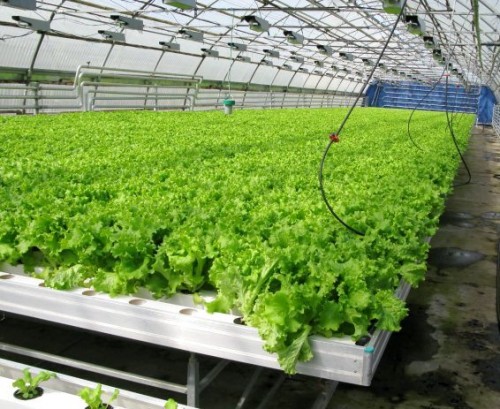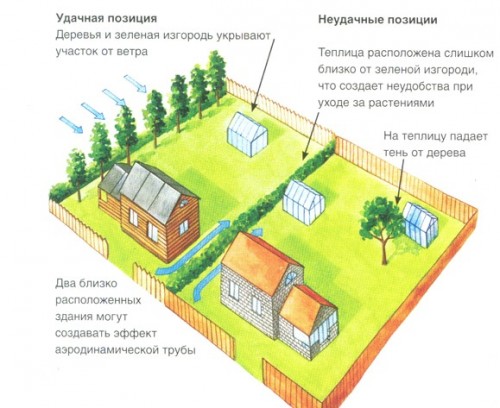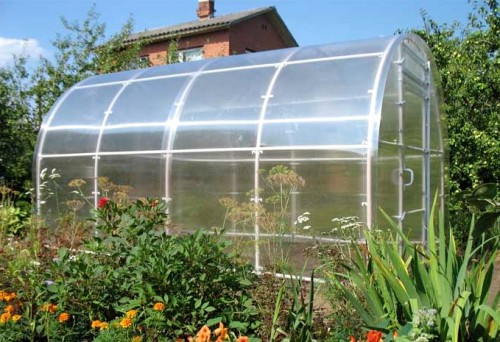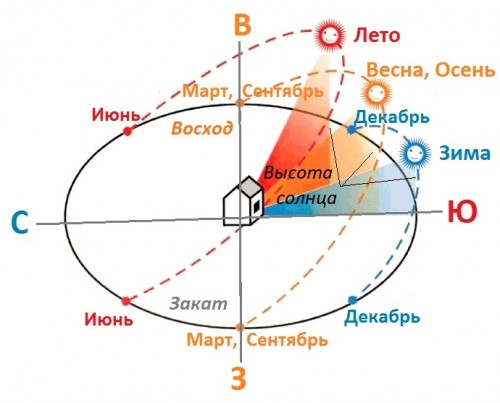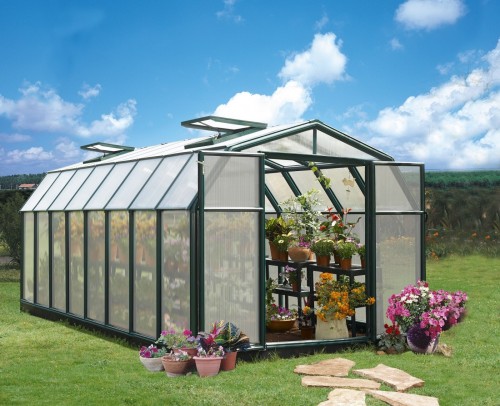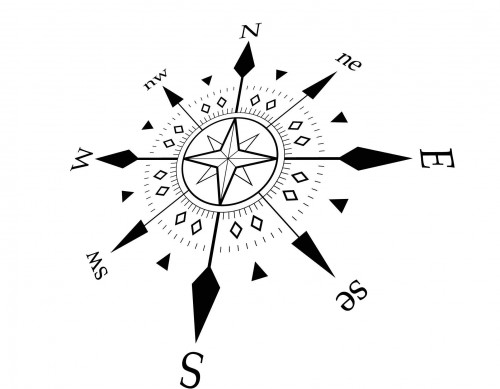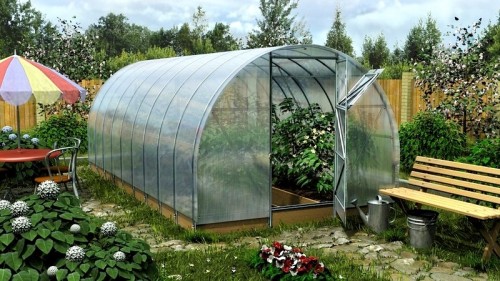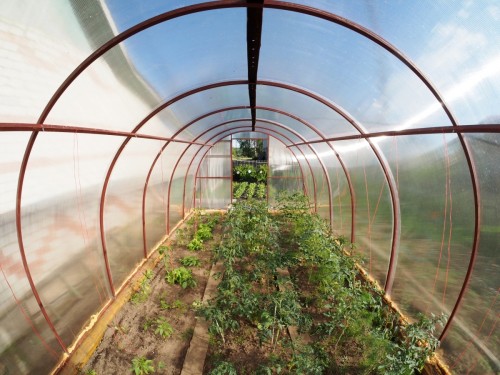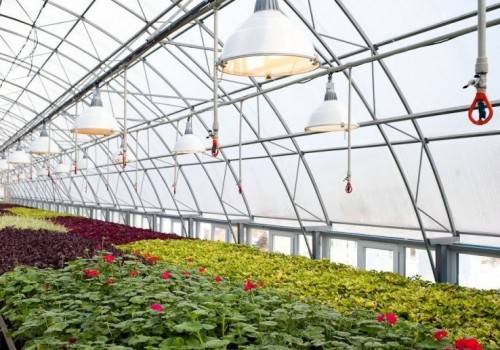When planning how to arrange a greenhouse on the house territory, it is important to consider not only the structural features of the structure, its size and type, but also the location. To resolve this issue, a number of fundamental factors should be taken into account. The greenhouse in the country is a coordinated design, the work of which depends on the environment, despite its closeness.
Content
The factors for the location of the greenhouse
Choosing methods of how to place a greenhouse on the site , it is worth considering several factors. Their compliance will allow you to correctly place the structure under the optimal wind load, with the connection of the necessary communications and observing the focus of the lighting. This will save the owner of the solution of such unpleasant consequences as:
- the formation of an inappropriate microclimate;
- lack of crop;
- poor germination of plants;
- unregulated temperature regime;
- condensation formation.
In order to achieve high quality indicators of the grown products and simplify the process of operating the greenhouse, it is important to consider the following criteria for placing the structure:
- The focus of light is the main factor on which the growth of the growth of plantings depends. The level and angle of falling illumination into the greenhouse is of paramount importance and the orientation must be observed by the cardinal points. You should also avoid the location of the structure in the area where the sun's rays will block trees, buildings or houses.
- The landscape characteristics of the site - they include the presence of water bodies, the slope of the site, the degree of freezing of the soil, as well as the level of lift of groundwater.
- Convenience of location - involves the presence of all communications that ensure the maintenance of the greenhouse, as well as the entrance and inputs.
- The quality of the soil - given the fertility, aeration, susceptibility to erosion, excrement, etc. Criteria, the correctness of the structure of the structure in one place or another will depend.
Consider each factor in detail in order to be able to decide on the choice of location of the structure on its territory.
Landscape characteristics
This factor has an important effect when choosing a place where to place a greenhouse on the site . Usually, novice gardeners make a common error, placing a design in a remote zone, where it will not become an obstacle to the owners and will not take a valuable place in the middle of the site. However, building a greenhouse at the far corners of the territory, you deprive yourself of the possibility of quick and comfortable access to it. It is worth remembering to summarize communications and water supply, the cost of which will increase as the structure is remote.
Experts recommend adhering to the following criteria when choosing a place to place a greenhouse:
- The optimal place for the design is as close to the house as possible. Experienced gardeners seek to attach the construction directly to the dwelling, since this is the most economical and profitable option.
- An important role in choosing a place is assigned to the characteristics of the slope and the quality of the soil. It is necessary to build a greenhouse only on the canopy base, while the soil should not be too soft or loose. If you have a greenhouse in the lowland, then you need to take care of providing a drainage layer.
- The best side for building a greenhouse is southeast, south or southwest. This placement will eliminate several pressing problems at once, since this is ensured by sufficient lighting and reliable protection against wind.
- The ideal option is to place the structure on the hill, setting the basis on durable and dry soil. It is important to observe that the structure is located from east to west. This will allow the maximum flow of sunlight inside.
Placement on the cardinal
Lighting on the sides is an equally significant factor when choosing a greenhouse construction zone. Without natural sunlight, plants will not be able to develop, and equipping the structure with artificial sources will not solve the problem. Therefore, for the correct installation of a greenhouse structure, the solution of this issue is in priority.
The sun is an indispensable source of energy. The development and use of high -tech materials for the construction of greenhouses allows today to ensure high penetration of rays inward - up to 90%. However, this is possible under ideal conditions for orientation of the greenhouse to the cardinal points. Since in the summer and winter periods the sun is in different positions, the task of the gardener is the construction of the structure so that plants can absorb the maximum of penetrating solar energy in any period.
Among the most important recommendations for installing a greenhouse, the following can be distinguished:
- The optimal location of the greenhouse on the cardinal points is a direction from east to west. This rule applies to large -sized farm buildings. So you can ensure the alignment of temperature, uniform penetration of rays on the beds and better air circulation.
- For structures with small dimensions, the best direction is the location from the north side to the southern, or from the eastern to the western one. Here, only the convenience of the approach and supply of communications plays the role.
- Despite all the rules for installing the greenhouse to the cardinal points, during the frost period, the installation of additional lighting will be required, since the natural daylight hours are quite short in winter. Therefore, take into account the possibility of bringing cables to the construction.
Wind load accounting
To determine the optimal location of the greenhouse in the summer cottage, it is necessary to take into account the pre -emptive direction of the wind and the degree of protection of the construction from powerful impulses. This factor is of particular importance when the winter period occurs and the cold wind provokes significant heat loss inside the greenhouse. This phenomenon is not uncommon and entails additional costs for heating the space.
Important! For the correct location of the greenhouse structure, carefully study the wind rose scheme on the planned area, determining the most calm and purged place of your site.
There are two main options that provide reliable protection against gusts of wind and remove the wind load. These include:
- Building a dull fence or hedge. Such designs should not exceed 1.5 m of height in order not to prevent the penetration of sunlight into the territory. It is also necessary to observe the correct distance at which it is worth installing a fence. So, at the height of the greenhouse structure of 2-2.5 meters, the fence should be located at least 7 meters from the construction. Important! This option for protecting the greenhouse has one drawback - with intense movement of air flows, the wind can create a turbulent vortex, running into a continuous barrier. This is fraught with cooling the walls of the greenhouse. In the case of the construction of a hedge, such a phenomenon disappears, but it is advisable to plant thick bushes at least 20 meters from the greenhouse.
- The best option for eliminating the wind load on the structure is its connection to the wall of the house. It is also permissible close to residential building, however, the level of illumination should be taken into account so that the walls of the building do not overlap the flow of sunlight.
Soil characteristics
The quality of the greenhouse economy is influenced by the quality of the soil. This factor determines the characteristics of the resulting crop and its abundance. Therefore, it is necessary to adhere to a number of simple recommendations in order to avoid errors in the orientation of the building. Consider them in more detail.
- The design must be installed on a gentle area. If this requirement cannot be fulfilled, the surface of the site should be leveled through technology and the soil pouring into the recess.
- Avoid intensive soil compaction, since this is how the natural structure can be disturbed.
- If the soil is predominantly clay, it should be covered with gravel, and then filled with a layer of chernozem.
- It is advisable to conduct a geological examination before starting construction work. So it is possible to identify the degree of suitability of the selected area for installing a greenhouse structure. For example, swampy or sandy soil is not suitable for this construction, since accumulating moisture will soon affect the strength of the structure. Experts will help resolve a number of issues, and the owner will save finances and time.
The presence of communications
When the purpose of installing a greenhouse is a year -round use, it is worth considering such a factor as the convenience of maintenance of the structure. The owner needs to ensure the functioning of the heating, water supply and electrical wiring system. These additional conditions will allow you to grow a quality crop without much effort.
To simplify the choice of place and operation of the greenhouse, it is important to adhere to the following tips:
- The savings of financial resources for conducting communications systems will be directly proportional to the distance of the structure from the house. The closer the greenhouse to residential construction, the more profitable it is to serve it.
- The installation of a central water supply system will significantly facilitate work in a greenhouse. In addition, communications data allow you to place both automatic and semi -automatic devices for watering the beds.
- It is recommended to lay the central water supply at the time when work is underway to pour the foundation of the greenhouse.
- It is advisable to think through the presence of entrances, paths and access roads to construction at the stage of building planning.
Compliance with these simple recommendations will allow the owner of the greenhouse to receive maximum pleasure from the lesson, with minimal labor and financial costs.
How to maintain heat inside the structure?
Providing all the subtleties and features of the structure, location and maintenance of the greenhouse, there is always the likelihood that it is impossible to overcome natural forces entirely. Even if the erected structure is sufficiently warmed up by sunlight from above, the cold can penetrate the soil and spoil the roots of the plants. This phenomenon is quite common in greenhouses located directly on the ground.
Adhering to several techniques, you can avoid heat loss and improve the quality of the resulting crop. Consider them in more detail:
- If the material of the manufacture of the greenhouse is glass, it is more advisable to use double sheets with a 2 mm thick, gluing them with transparent glue. Such products are placed in the frame on the principle of double glass.
- To eliminate heat transfer between the soil inside and outside the greenhouse, it is necessary to build it on a basement of 50-60 cm high. The material for the basement is aerated concrete, foam concrete, expanded clay concrete, arbolite, etc.
- It is possible to achieve the maintenance of heat and inertia inside the greenhouse by lifting the beds from the ground by 50 cm. This will maintain heat and cultivate a plentiful crop.
Recommendations for choosing a greenhouse’s designs can be seen on the video fragment:

